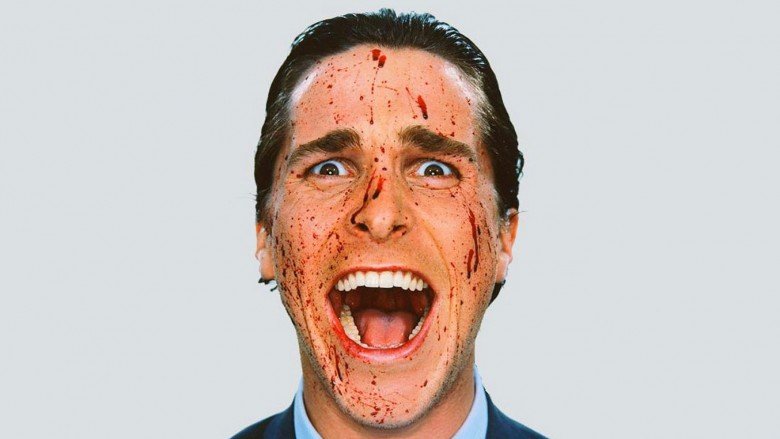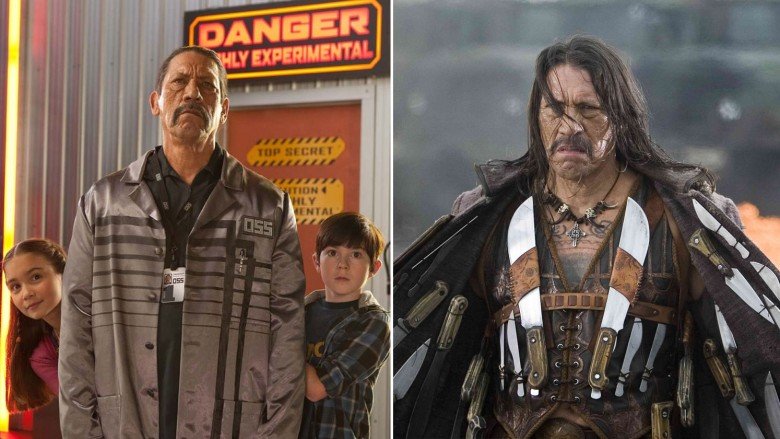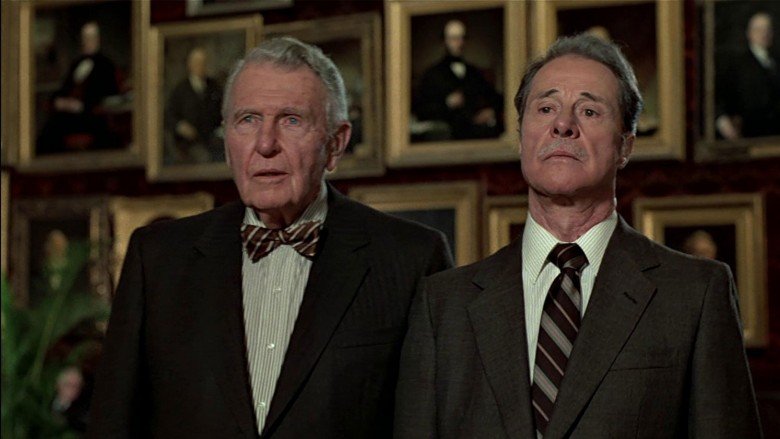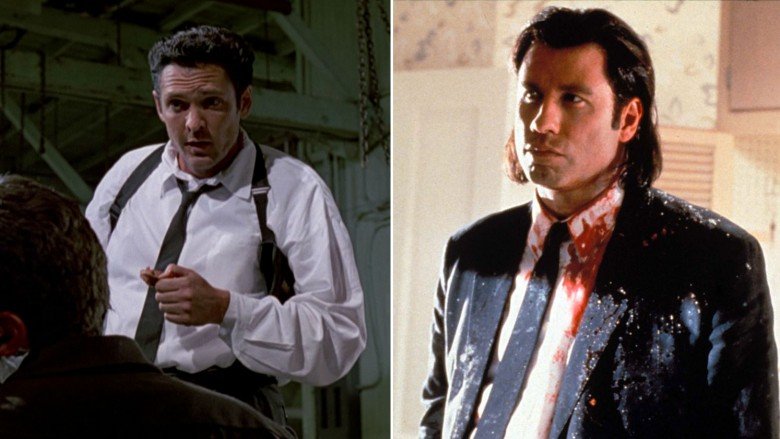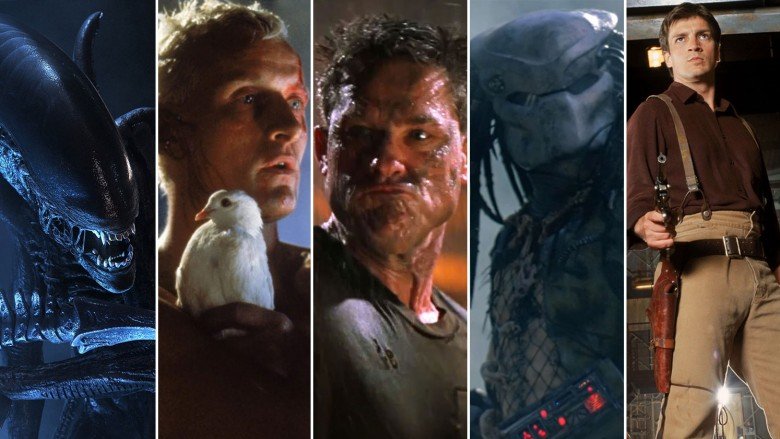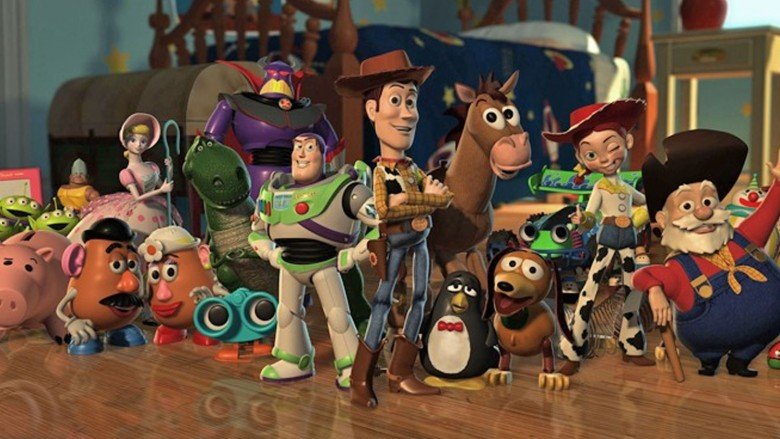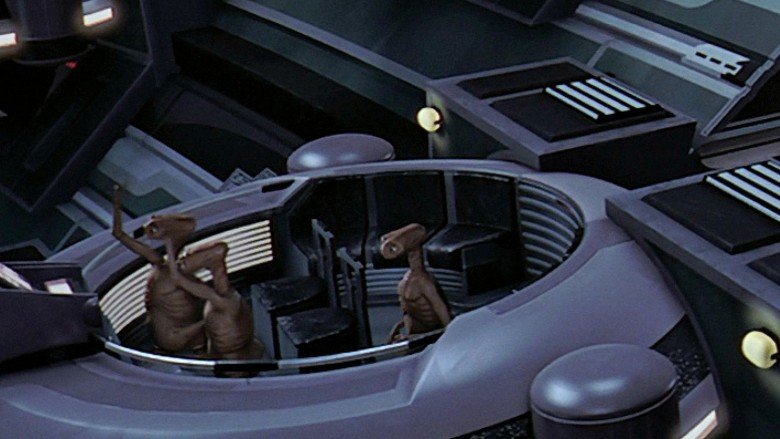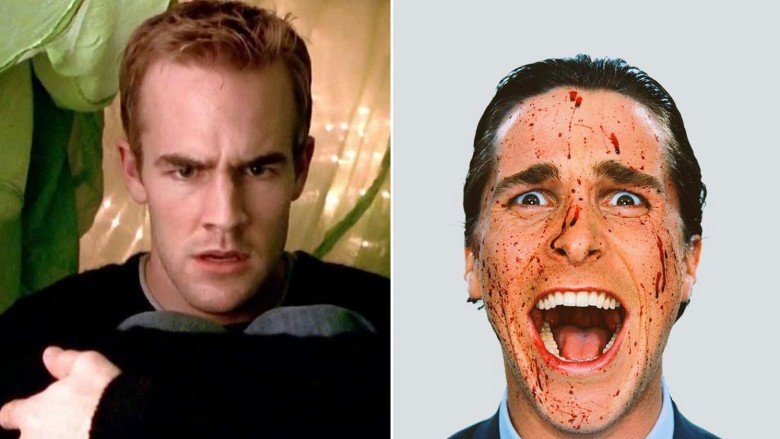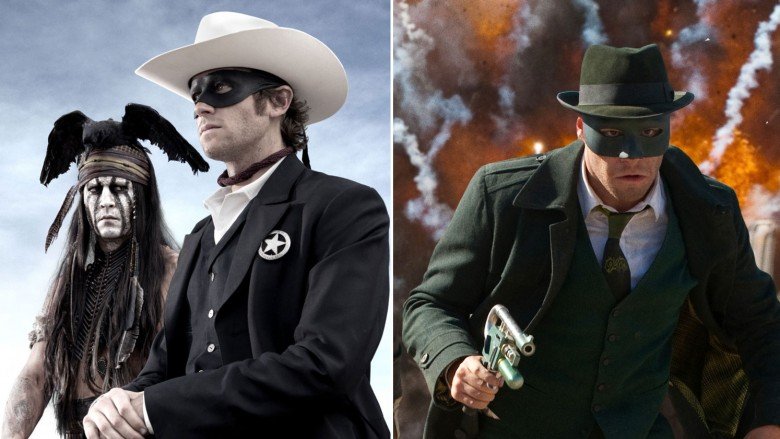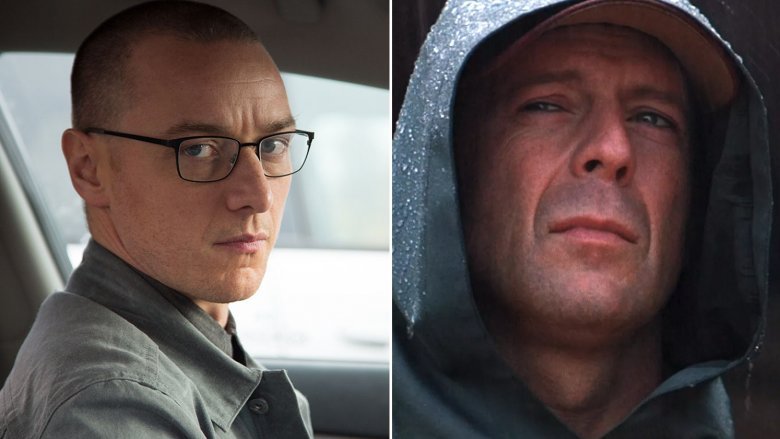Clever Movie Crossovers You Totally Missed
Sometimes, it's just fun to take characters from different franchises and put them in the same movie. Even if there's little rhyme or reason for it, movie crossovers frequently fall into either the "good" or "so bad they're good" categories. While you probably know about some of the more obvious major crossover movies like Freddy vs. Jason or The League of Extraordinary Gentlemen, what about some of the more obscure crossovers? Let's take a look at some movie crossovers that might seriously surprise you. Don't blink, or you might miss it!
Spy Kids and Machete
That's right, the helpful gadget-creating uncle from Spy Kids is the same dude who later goes on a mission for vengeance and blood in the violent Machete and Machete Kills movies. Machete actor Danny Trejo originally came to the attention of director Robert Rodriguez in the 1990s on the set of Desperado. Rodriguez explained his decision at the 2007 SXSW festival. "When I met Danny, I said, 'This guy should be like the Mexican Jean-Claude Van Damme or Charles Bronson putting out a movie every year, and his name should be Machete.'" The pair would reunite on the set of Spy Kids, which Rodriguez also directed.
In Spy Kids and its sequels, "Uncle Machete"—and his plethora of super-cool spy gadgets—comes to the aid of the Cortez children against a variety of enemies. In 2007, Rodriguez would team up with Quentin Tarantino for the horror double-feature Grindhouse, which had fake trailers for nonexistent movies, including one for Machete. After making the trailer, Rodriguez decided to go ahead and give Uncle Machete his own full-length film—which earned a sequel, 2013's Machete Kills, featuring a new character played by Trejo's former Spy Kids co-star Alexa Vega.
Trading Places and Coming to America
In Trading Places (1983), the rich and educated Louis Winthorpe III (Dan Aykroyd) and the street hustler Billy Ray Valentine (Eddie Murphy) are forced to switch lives through the orchestrations of business magnate brothers Randolph and Mortimer Duke. After it becomes evident that the Duke brothers are more nefarious than they appear, Winthorpe and Valentine team up to take them down, ruining their business and leaving them destitute. Five years later, another Eddie Murphy movie would show us what became of the Dukes after their downfall. In 1988's Coming to America, Murphy plays an incredibly wealthy prince who travels to the United States in search of a bride who will love him for who he is rather than for his money. To further that goal, the prince gives all his remaining money to a pair of homeless men—who turn out to be the Duke brothers. In perhaps one of the best cameo one-liners ever, Randolph exclaims, "Mortimer, we're back!" If only Hollywood had made a sequel about the Dukes before actors Ralph Bellamy and Don Ameche passed away in the '90s.
Caddyshack, Ghostbusters, and Casper
Robert Rodriguez wasn't the only director who enjoyed using characters across several of his films. Harold Ramis, who directed Caddyshack (1980) managed to sneak one pretty amazing crossover cameo into another of his movies, Ghostbusters (1984). We all remember the iconic character of crazy greenskeeper Carl Spackler from Caddyshack, played to perfection by Bill Murray. In a deleted scene from Ghostbusters, the now-homeless Spackler can be seen walking through Central Park with another bum (played by Dan Aykroyd) debating politics and martial arts. Eleven years later, director Brad Silberling got in on the crossover action, adding a brief scene into Casper (1995), which features Dan Aykroyd's Ghostbusters character Raymond Stantz running away in terror from the haunted Whipstaff Manor.
Quentin Tarantino's two connected universes
For years, movie fans have speculated that all of Quentin Tarantino's movies take place within the same universe, and Tarantino himself confirmed in 2016 that the theory is mostly correct. There are actually two universes within his films—one is the "real" world in which many of the characters live, and the other is the "movie" world containing films that the people in the "real" world would go and see. "So From Dusk Till Dawn, Kill Bill–they all take place in this special movie universe," Tarantino explained. "So when all the characters of Reservoir Dogs or Pulp Fiction, when they go to the movies, Kill Bill is what they go to see. From Dusk Till Dawn is what they see."
In one notable instance of Tarantino-ception within his "real" world, Mr. Blonde, aka Vic Vega from Reservoir Dogs (1992), is actually the brother of Vincent Vega from Pulp Fiction (1994). Tarantino revealed in an interview that he had considered making a movie focused on the Vega brothers, with Michael Madsen and John Travolta reprising their roles. With both actors aging and Tarantino also claiming that he only has two movies left in him, it may be too late to hope against hope that one of them will be a Vega spin-off.
Daredevil and Teenage Mutant Ninja Turtles
That's right, superheroes Daredevil and the Teenage Mutant Ninja Turtles were both created by the same freak accident—and a massive copyright loophole. According to TMNT creators Kevin Eastman and Peter Laird, they came up with the concept of the Turtles' origin story in 1983 by drawing from the first 1963 issue of Daredevil. In that issue, a truck carrying hazardous chemicals nearly hits a man crossing the road, and a young Matthew Murdock saves the day by pushing the man out of the way—but he is struck across the face with a canister of the chemicals, both blinding him and giving him his superpowers. That's where the Turtles' tale takes over. In their origin story, Master Splinter describes the accident and the canister bouncing, knocking a glass jar out of the hands of a child on the sidewalk, which shatters, causing four tiny turtles to fall into the sewer grate below. The canister falls through the storm drain, too, smashing and covering the turtles in a mysterious glowing ooze.
The Daredevil references don't stop there, however. Laird and Eastman named ninjutsu expert Master Splinter in homage to Stick, who serves as sensei to a young Matt Murdock. Additionally, the primary supervillain organization encountered in Teenage Mutant Ninja Turtles is "The Foot," while the counterpart group from Daredevil is called "The Hand." With all these references to another studio's work, it's surprising that no copyright infringement claims have been raised by the Daredevil creators over the years. Maybe that's the real secret behind "Turtle Power"—keeping lawyers away.
Alien, Blade Runner, Soldier, Predator, and Serenity
Did you know that some of the most beloved science fiction franchises in existence are all related or possibly in the same "universe?" While it had long been speculated that there was a connection between the Alien and Blade Runner worlds, the idea was essentially confirmed with the DVD release of Prometheus. In one of the bonus features on the disc, you may read a letter from Peter Weyland, in which he talks about his mentor in robotics, and how it eventually all "blew up in his face." For those who know their Blade Runner history, it becomes quickly evident that Weyland is referring to none other than Eldon Tyrell, head of the Tyrell corporation from Blade Runner. This revelation sets Prometheus (in 2089) between the original Blade Runner (set in 2019) and the first Alien film (about 2122) chronologically, creating an overlap further hinted at in Blade Runner: 2049.
In addition to this confusing and intriguing timeline, there's also the link to the 1988 sci-fi film Soldier, which is considered an unofficial sequel/sidequel to the original Blade Runner. Additionally, die-hard fans of Joss Whedon's series Firefly (and subsequent movie, Serenity) can tell you that the logo on Mal's turret gun in the pilot episode belongs to none other than the Weyland-Yutani corporation from the Alien franchise. Given that Weyland-Yutani folded around 2349 and that the Battle of Serenity Valley was in 2511, it's a perfect example of how outgunned the Browncoats were against the Alliance—they were using 150-year-old artillery technology. Finally, there's the whole Predator connection, which was thoroughly explored in two completely unnecessary Alien vs. Predator movies.
Every Pixar movie
As of 2016, Pixar has produced seventeen different movies since the studio was formed. But did you know that all of those 17 films are at least interconnected, if not set within the same universe? According to movie critic Jon Negroni's conspiracy theory, it goes deeper than that. He says the world of Pixar movies is apparently run by mega-corporation Buy n Large, which has taken over governments around the world. Beyond Negroni's theory, the connections can be traced through an impressive number of Easter eggs the Pixar animators have left sprinkled through their films, including the ever-popular "Pizza Planet" truck, which appears in nearly all of the studio's movies. Pixar itself confirmed some of these connections in early 2017, when it released two different videos featuring all the Easter eggs from Pixar movies you might have missed.
Rango and Fear and Loathing in Las Vegas
While we're on the topic of animated movies, let's talk about Rango. This 2011 children's feature film from Gore Verbinski has much more in common with Fear and Loathing in Las Vegas than you might realize. Both movies feature Johnny Depp in the main role, and the title character in Rango wears a flowered shirt much like Hunter S. Thompson's alter-ego "Raoul Duke" from Fear and Loathing. At one point, Rango gets briefly plastered to the windshield of a passing vehicle, which happens to be the same convertible from Fear and Loathing, driven by an instantly recognizable Hunter S. Thompson, with his lawyer "Dr. Gonzo" in the back seat. Additionally, there's a scene in Fear and Loathing in Las Vegas where Thompson (on acid) sees a bunch of clothed, talking lizards. Given the themes of existentialism prevalent throughout Rango, it makes you wonder if maybe the entire movie may have taken place in the hallucinations of Thompson as he drove through the desert.
Star Wars and E.T.
This movie crossover was deliberately planned by both Steven Spielberg and George Lucas. Most people probably don't know or remember that the first time we hear the name "Boba Fett" is from the lips of Elliot, the lead character in E.T. You probably remember the scene from E.T. where the kids encounter a child dressed in a Master Yoda costume, to which E.T. responds excitedly, "Home!" This wasn't the first time Spielberg had sprinkled Star Wars references in his films. In Close Encounters of the Third Kind, you can spot a model of R2-D2 hanging from the spaceship, and in Raiders of the Lost Ark, both R2 and C-3PO can be seen in Egyptian hieroglyphics. For his part, Spielberg's buddy Lucas returned the favor in 1999, when he included a delegation of E.T.-like aliens as members of the Galactic Senate. While much of their new backstory was later retconned after Disney purchased the rights to Star Wars, the E.T. aliens are known as Asogians and their leader in the Senate was named Grebleips–"Spielberg" spelled backward.
The Rules of Attraction and American Psycho
If you're familiar with the source material for these two very different movies, then you probably already know about the connection between The Rules of Attraction and American Psycho. If you're not, then here's a brief explanation: Sean Bateman (played by James van der Beek) in 2002's The Rules of Attraction is actually the younger brother of Patrick Bateman (played by Christian Bale) from 2000's American Psycho. Patrick's character (played by Casper Van Dien) was supposed to actually make a brief appearance in The Rules of Attraction, but all of his scenes were cut before the movie was released.
Author Bret Easton Ellis penned both of the novels that these movies are based on, along with Less than Zero and Informers—with storylines and characters that all interconnect with the universe of the Batemans. Unless you're writing everything down, the revolving door of characters found in Ellis' novels can get quite confusing. (Those who have gone before us have done the confusing work of parsing things out.)
The Lone Ranger and The Green Hornet
While it can't be acknowledged openly today by either of the characters, the Lone Ranger and The Green Hornet are actually related. Back when both characters were in their early days of radio serials, it was established early on that Britt Reid (The Green Hornet) was the descendant of John Reid (The Lone Ranger). Depending on the canon source, John is described as either Britt's uncle or great uncle. Much later, both properties were sold to different studios, so neither studio can bring one character into the other series. While movie crossovers are out, the comic book rights are a slightly different story. In 2016, Dynamite Comics obtained the rights to both characters in book form and then tapped Michael Uslan to pen a crossover comic book series that explores their familial connection. It's available in graphic novel form, too!
Split and Unbreakable
After a string of poorly-received films, director M. Night Shyamalan's career seems to be taking a recent upswing. His 2015 "found footage" horror movie The Visit was a huge success, and Shyamalan followed that up with another hit, the 2016 psychological thriller Split. For fans of Shyamalan's earlier work, the way that Split ended may have thrown you for a loop—yes, that was a cameo by Bruce Willis.
Split's troubled antagonist, Kevin Crumb, has been nicknamed "The Horde," and he may even be manifesting superhuman abilities. A woman watching the news in a diner comments that it reminds her of a similar story from 15 years ago involving a man in a wheelchair. Unbreakable's David Dunn (Willis) chimes in from the bar, saying, "Yeah, Mr. Glass." This is obviously a reference to the wheelchair-bound villain (Mr. Glass/Elijah Price) from Unbreakable, played by Samuel L. Jackson.
We don't want to give too much away, but this appearance by Willis was more than just a quick bit of fanservice. They cut the cameo from test screenings in order to keep it a secret, and Shyamalan revealed that the character of Kevin actually appeared in early versions of the script for Unbreakable. That makes Split actually a sequel to Unbreakable, set some fifteen years later. If that weren't exciting enough on it's own, Shyamalan also revealed that he has plans to write a third movie, which will feature the characters of both Split and Unbreakable.
In April 2017, Shyamalan unveiled that sequel. Slated for a 2019 release, Glass will feature David Dunn pursuing Kevin Crumb "in a series of escalating encounters, while the shadowy presence of Price (Jackson) emerges as an orchestrator who holds secrets critical to both men." We can't wait!
